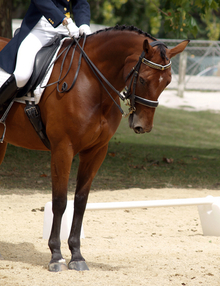When viewers see a horse's neck being hyperflexed during some equestrian events, concerns arise about the way the horse is being treated and trained and some people question whether the horse is being physically injured during the process.

Analyzing horse training methods
Often people become concerned about injury or trauma when the horse's neck is fully extended forwards and downwards or hyperflexed so that the head almost comes into contact with the chest.
There has been much debate about whether the horse's neck should be fully extended forwards and downwards or “hyperflexed” such that the head almost comes into contact with the chest?
Now, the team of Christine Aurich at the University of Veterinary Medicine, Vienna has compared the levels of stress on horses trained by two methods and has found surprisingly little difference in the results. Their findings will be published in the “Journal of Animal Physiology and Animal Nutrition”.
The work was carried out at the Graf Lehndorff Institute for Equine Science, a joint research unit of the University of Veterinary Medicine, Vienna, Austria, and the Brandenburg State Stud at Neustadt (Dosse), Germany.
Mareike Becker-Birck compared the levels of stress shown by sixteen horses trained on the lunge with their necks either extended forwards or fixed in hyperflexion.
She assessed stress by monitoring the levels of cortisol in the animals’ saliva and by following the heart rate and the fluctuations in heart rate exhibited before, during and after training.
In addition, the surface body temperature was measured before and after the experiment. None of the horses suffered any obvious discomfort during the training, which was undertaken without the use of a whip.
The horses showed an increase in cortisol in their saliva, an increase in heart rate and a decrease in heart rate variability when they were trained. These changes presumably stem from a combination of physical activity and the normal stress responses.
The level of stress incurred by the animals was not particularly high – the change in cortisol in the saliva was actually less than when horses are transported by road or ridden for the first time.
Importantly, the effects were the same irrespective of whether the animals were lunged under hyperflexion or under “classical” conditions with their necks extended. The only significant difference observed related to the temperature of the front (cranial) part of the animals’ necks, possibly indicating that the blood flow was not quite even when the horses were lunged in hyperflexion.
Apart from this one minor difference, the results show that hyperflexion in horses lunged at moderate speed and not touched with the whip does not elicit a pronounced stress response. The researchers state that there appears to be no scientific reason to ban the use of hyperflexion.
Aurich nevertheless remains cautious. “Our results show that hyperflexion does not itself harm the animals but some trainers combine it with forceful and aggressive intervention of the rider over prolonged periods of time. This is a different situation from the one we investigated so our study should not be interpreted to mean that hyperflexion never has any stressful or negative effects.”
